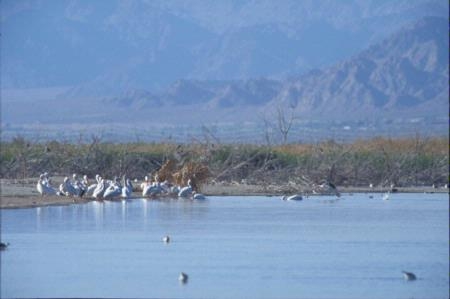Scientists seek solutions to Salton Sea woes
The rotten-egg stink that invaded Southern California in September was blamed by scientists on an unfortunate combination of a large fish die-off in the Salton Sea, a storm churning the fetid lower levels of the sea and unusual gusts from the southeast blowing the odors toward Los Angeles, according to the Los Angeles Times.
That was just latest episode in a series of environmental woes for the lake that formed 150 miles southeast of Los Angeles in 1905 when the Colorado River flooded the Sonoran Desert. Now the Salton Sea is mainly fed by fresh water drainage from nearby farms and waste water from Mexicali, but becoming more salty as evaporation outpaces its replenishment. UC scientists are working on ways to improve the quality of the inland sea to make it more hospitable to wildlife.
Nitrogen and phosphorus are two main nutrients that spur algae growth and lower dissolved oxygen concentrations that cause massive fish kills in the Salton Sea.
Imperial Valley growers often fertilize their crops with nitrogen and phosphorus in irrigation water. Khaled Bali, UC Cooperative Extension advisor in Imperial County, gives growers “best management techniques” to ensure fertilizers are applied correctly so the nutrients end up the plants, not flowing into the Salton Sea.
“One of the irrigation management practices that we developed at the UC Desert Research and Extension Center is used in the valley to conserve water and improve water quality,” Bali said. “Implementation of this practice on commercial farms increases water use efficiency by more than 12 percent and reduces the load of sediment and soluble phosphorus in drainage water by more than 50 percent.”
A recent UC Berkeley study has demonstrated a cost-effective method for using manmade wetlands to clean contaminants out of the waters that flow into the sea, which is overly salty from evaporation and polluted with selenium, fertilizer nutrients and other chemicals from agricultural run-off.
The study was aimed at providing a wildlife habitat at the south end of the sea with low-salt, clean water, but the new wetland design also has the potential for broader environmental and agricultural applications, researchers say.
“No other published studies have shown any cost-effective system that approaches this level of efficient selenium removal,” said Norman Terry, professor in the Department of Plant and Microbial Biology at UC Berkeley, and principal investigator of the study. “The only other way to get water this clean is to use microbial bioreactors, which are prohibitively expensive and not feasible on the vast scale of the Salton Sea.”
In the proposed multi-step process, water from the Alamo or New River would be pumped into a sedimentation pond, and then allowed to flow through an algae pond and into a constructed wetland growing cattail plants before it finally enters into the species conservation habitat.
Terry’s next step is to obtain funding to build a pilot wetland to test the design in the field.
The study, published in the November 6 issue of Environmental Science and Technology, was funded as part of the California Department of Fish and Game's and Department of Water Resources’ efforts to develop pilot restoration projects that provide feeding habitat for migratory, fish-eating birds.


